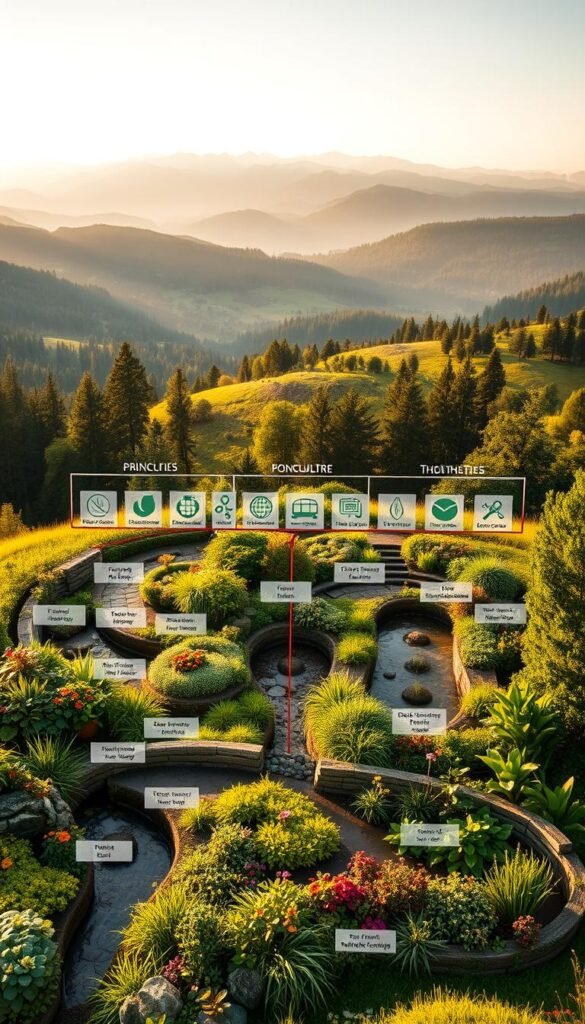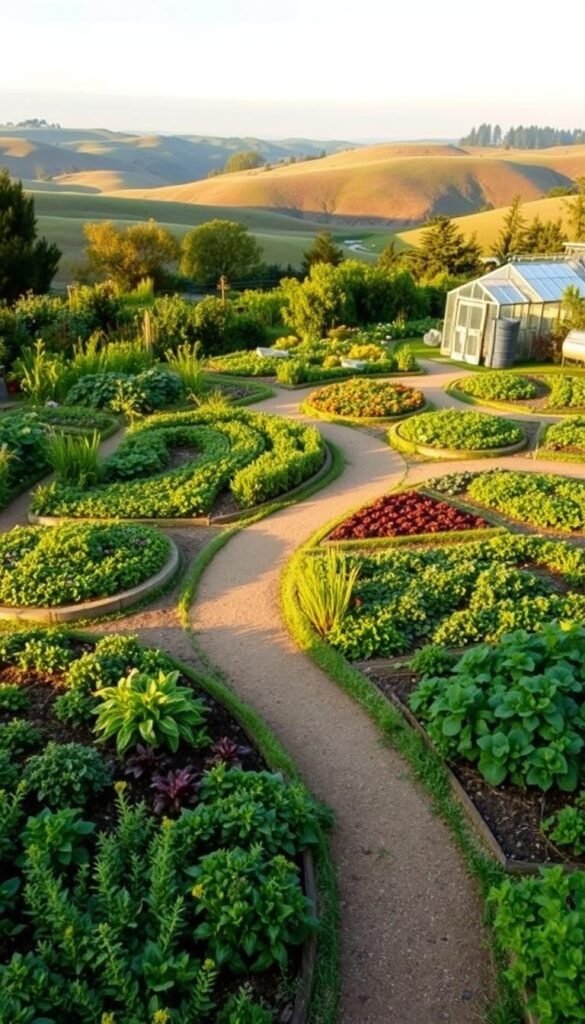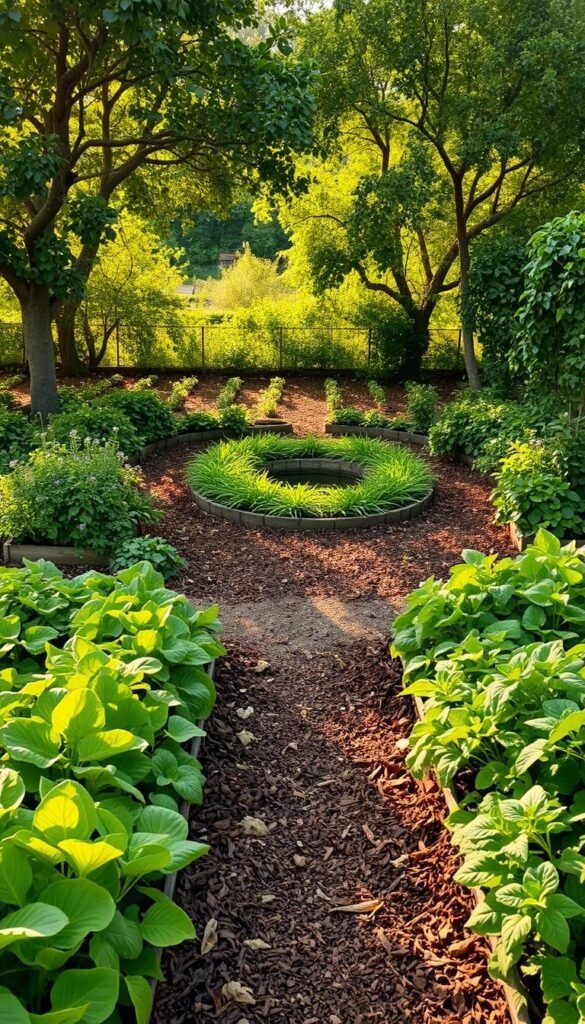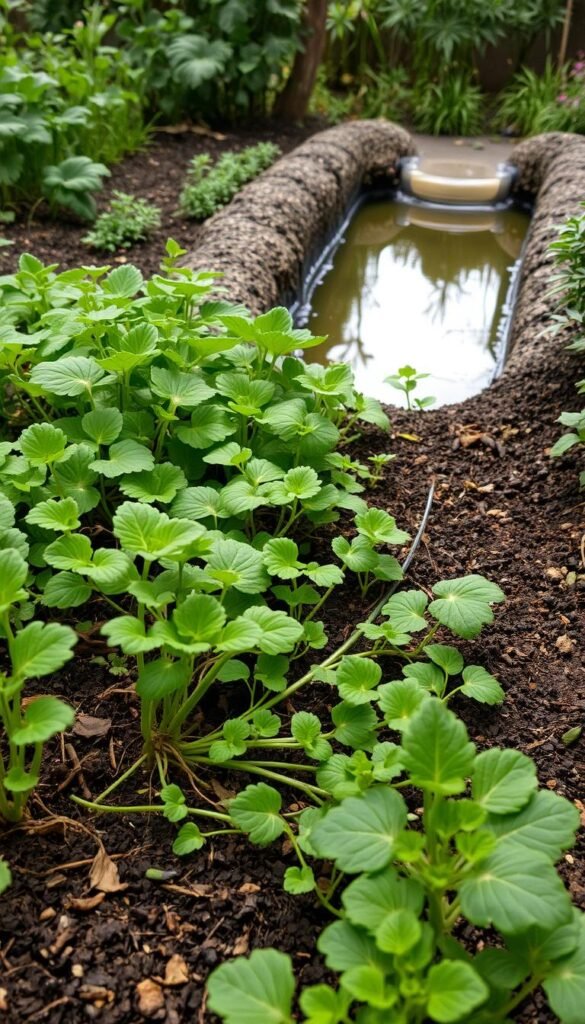Imagine creating an outdoor area that feeds your family while nurturing the environment. This approach blends ancient wisdom with modern ecology, focusing on designing spaces that mimic natural patterns. Unlike traditional methods, it prioritizes long-term harmony between plants, animals, and people.
At its core, this method combines two powerful ideas: creating lasting food sources and working with nature’s rhythms rather than against them. You’ll discover how simple changes like companion planting or rainwater collection can yield 40% more vegetables while supporting bees and butterflies.
Small spaces thrive too! Even balcony gardens can become productive ecosystems using vertical growing and smart soil techniques. Core design strategies help you position plants where they’ll naturally resist pests and drought. Over time, your plot becomes more self-sufficient – needing less watering, weeding, or store-bought fertilizers.
This isn’t just about growing food. It’s about crafting living systems where every element supports multiple needs. Fruit trees provide shade for shade-loving crops, while chicken coops naturally fertilize vegetable beds. You’ll learn to see your yard as an interconnected web of relationships, where “waste” becomes resources and problems reveal solutions.
Understanding Core Permaculture Principles

Transform your outdoor space using nature’s rulebook – a set of guiding ideas that help landscapes flourish. These time-tested concepts teach you to work smarter, not harder, while boosting biodiversity.
Fundamentals of Earth-Conscious Cultivation
Start by becoming a landscape detective. Track sunlight movement for 72 hours before planting. Notice where water pools after rain. These observations help position plants where they’ll thrive naturally.
Harness free resources like afternoon breezes for seed dispersal. Convert fallen branches into trellises. One gardener increased tomato yields by 65% simply by redirecting roof runoff to thirsty plants.
Reading Nature’s Blueprint
Copy how forests layer plants vertically. Tall fruit trees shelter berry bushes, which shade root vegetables below. This mimics natural ecosystem patterns where every plant has multiple roles.
Create circular systems instead of straight rows. Compost scraps to feed worms that aerate soil for new seedlings. Your space becomes a living loop where outputs become inputs – like using chicken manure to fertilize corn stalks that later feed the flock.
Through these core principles, you’ll develop landscapes that grow more productive each year. Your efforts shift from constant maintenance to strategic nudges that let nature do the heavy lifting.
Designing Your Garden for Efficiency and Resilience

Your outdoor space becomes a living blueprint when you work with nature’s patterns. Start by studying sunlight, wind, and soil over several days. This groundwork helps you position crops where they’ll thrive naturally, saving time and resources long-term.
Conducting a Site Analysis and Layout Planning
Track where morning sun hits hardest and where shadows linger. Note wind directions that might dry out soil or damage tender shoots. Test soil pH with a simple kit – acidic areas suit blueberries, while alkaline spots favor asparagus.
Sketch your space with zones based on how often you’ll visit each area. Herbs and salad greens belong near doors for quick harvests. Fruit trees can anchor distant corners, needing care only seasonally. Use slopes to guide rainwater to thirsty plants like squash or melons.
Optimizing Zones and Transitional Spaces
Edges between zones often burst with life. Line fences with climbing beans or nasturtiums. Turn shady borders into mushroom habitats. These transitions boost biodiversity while maximizing yields.
Group plants by water needs and pest resistance. Place aromatic herbs like rosemary near cabbage to deter pests naturally. Leave room for future expansion – start small with a kitchen garden, then add berry patches or compost systems as confidence grows.
Permaculture Gardening for Beginners: Building a Resilient, Eco-Friendly System

Launch your eco-conscious journey by focusing on small, impactful changes. Begin with a 4’x4′ area near your kitchen door – perfect for herbs and quick-growing greens. This manageable start lets you observe plant interactions and soil changes without overwhelm.
Step-by-Step Implementation Guide
Layer cardboard and straw over existing grass to create instant no-dig beds. Add compost and plant nitrogen-fixers like peas. One gardener transformed her clay soil in 8 weeks using this method, tripling worm populations.
| Phase | Action | Benefit |
|---|---|---|
| Month 1 | Establish composting system | Recycles kitchen waste into nutrients |
| Month 3 | Install rain barrels | Cuts water use by 40% |
| Month 6 | Introduce companion planting | Redces pests naturally |
Setting Goals and Establishing a Routine
Spend 15 minutes daily tracking plant growth and insect activity. Notice which areas dry fastest after rains? Those become ideal spots for drought-tolerant crops like rosemary or lavender.
Pair short-term wins with long-term visions. While waiting for fruit trees to mature, grow fast-producing veggies in their future shade areas. This layered approach keeps motivation high as you build toward organic garden resilience.
Enhancing Soil Health and Water Management

Nourish your garden from the ground up by focusing on two vital resources: living soil and smart water use. Thriving plants start with rich earth that teems with microorganisms and retains moisture naturally.
Building Fertile Soil With Organic Matter and Compost
Boost your soil’s fertility by mixing in kitchen scraps, fallen leaves, or grass clippings. These materials feed earthworms and beneficial fungi, creating air pockets that help roots breathe. One gardener doubled her carrot harvest simply by adding 3 inches of compost annually.
Start a compost system to recycle plant waste into black gold. Layer green materials like vegetable peels with brown matter like cardboard. Turn the pile monthly to speed decomposition.
Implementing Rainwater Harvesting and Mulching Techniques
Capture free water using barrels under downspouts. A single inch of rain fills a 55-gallon container from just 100 square feet of roof space. Use this chemical-free water for thirsty crops like tomatoes.
Blanket your beds with straw or wood chips to lock in moisture. Mulch reduces watering needs by 50% while suppressing weeds. As it breaks down, it adds nutrients back into the earth.
Natural Pest Control and Companion Planting Techniques
Turn pest problems into solutions by working with nature’s existing defenses. Healthy ecosystems balance predators and prey – your space can too, through strategic partnerships between plants and wildlife.
Embracing Beneficial Insects and Animals
Ladybugs devour 400 aphids weekly, while lacewings hunt whiteflies. Attract these allies by planting dill or yarrow. Even birds contribute – a single chickadee family eats 6,000 caterpillars during nesting season.
Create habitats with natural pest control strategies like brush piles for ground beetles. Ducks patrol slug-prone areas, leaving fertilizer as they roam. Balance is key – too few pests mean predators won’t stay.
Selecting the Right Plant Partners
Marigolds emit root chemicals that repel nematodes near tomatoes. Basil improves both flavor and pest resistance when planted with peppers. Beans fix nitrogen for corn, while squash leaves deter raccoons.
Mix flowering plants like calendula among veggies to confuse pests. For more organic pest control methods, pair garlic with roses to deter aphids. Diversity creates resilience – pests struggle where patterns change.
These approaches build self-regulating systems. Over time, your garden becomes a thriving web where every creature plays a role – including you.






